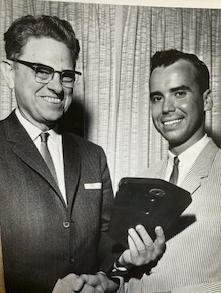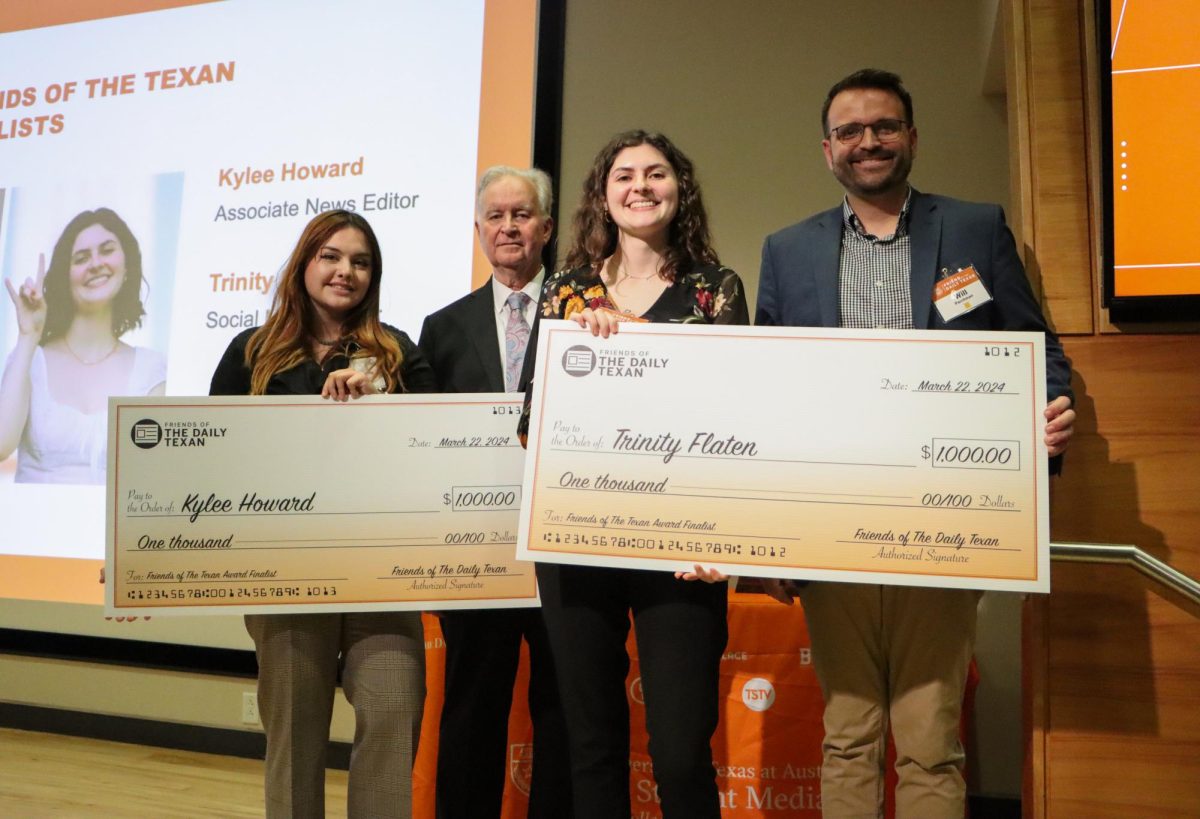Editor’s Note:
Richard Cole is a respected and internationally known educator and journalist who traces his background to The Daily Texan at the University of Texas at Austin, where he served two terms as Managing Editor. For 26 years he served as dean of the School of Journalism and Mass Communication at the University of North Carolina at Chapel Hill. Cole is a new member of The Daily Texan Hall of Fame. As part of that recognition, a colleague and longtime friend from his days at UT asked him to record some of his memories of student journalism at The Daily Texan in the 1960s. Below is his first-person account.
By Richard Cole
When I arrived at U.T. In fall 1960, I was a chemical engineering student but soon knew that wasn’t for me. I switched to journalism and loved it. That was natural since I’d always loved writing and was editor of my high school paper and co-editor of the yearbook. At first, I worked on The Texan as a reporter and later moved up the news ranks. I was also in the Longhorn Band and wrote stories for The Texan about the band, including one where elephants – yes – appeared with the band. Another was about the band’s leading the Texas delegation in the inaugural parade up Pennsylvania Avenue in Washington, D.C., in January 1961 when JFK became president and LBJ became vice president. I also remember working as a press assistant at the Texan Union for Shirley Bird Perry in my early years as an undergraduate, writing releases on coming Union speakers and all sorts of other Union activities and taking them to The Texan. That’s how I met Lynda Painter, who became my wife several years later, in 1968. As an undergraduate, she worked at the Union, was active on committees and taught dancing there. We were married 32 years before she died in December 2000 from cancer.

I started as managing editor of The Sumer Texan in June 1963. At that time, Dave McNeely was editor, Jim Davis was night editor, Martha Tipps was issue news editor, Pat Sharpe was desk editor, John Allman was copy desk chief, Bob DuPont was night sports editor (Bill Little was the assistant and soon became sports editor), Hayden Freeman was night amusements editor, Carolyn Coker was night feature editor, Mary Jane Gorham was editorial assistant, and Laura McNeil was assistant managing editor. Later James Vowell came on as night editor, and Frank Denton as copy desk chief.
The lead story in the first issue of The Summer Texan that year, on June 4, was about University registration, and the second lead was the death of Pope John XXIII. A story appeared inside on Willie Morris’s going to Harper’s magazine to be an assistant editor.
By the way, a subscription to The Summer Texan cost $1.50. The blanket tax at U.T. — which admitted students to athletic games, cultural events and Round-Up activities, and provided a subscription to The Texan – was $17.74. A regular haircut at Andy’s Barber Shop was $1.25. A good man’s shirt at Clyde Campbell University Shop on the Drag cost $6.95. Some of the big movies that summer were “Bye, Bye Birdie,” “Hud,” “Giant,” “Lawrence of Arabia,” “The Birds” and “Auntie Mame.” Incidentally, one perk of being M.E. of The Texan was a movie pass for two. I don’t remember if it was for all the movies in town or just one chain or what. But we rarely missed a good movie.
I had the lead story on June 11, from Tuscaloosa, Ala., on Gov. George Wallace’s barring the door of the University of Alabama to two Negro students: Vivian Malone and Jimmy Hood. I recall being there with Martha Tipps and Helen Yenne, two excellent staff members. Jim Davis was with us, paying his own expenses because he wasn’t a student at the time. But he actively gathered material and passed it on to us. President Eisenhower had sent in 500 National Guard troops. Tension was high. Reporters came from everywhere. A white semicircle had been drawn on the cement in front of the door to the campus building where Wallace barred the door, and a picture was taken of me as a reporter with my foot over the line. I very much appreciated the OK to take the trip to Tuscaloosa on Texan money. The approval came from Lester Loyd Edmonds, the head honcho of Texas Student Publications (TSP) who in my opinion was always sympathetic, even generous, about approving such reporting trips. And truth to tell, back in those days, The Texan seemed to have enough money to do whatever it wanted, in reason.

Along with Vietnam, the big news back then was race relations and integration. In one editorial-page column I wrote, “Reviewing Stand,” my opening was “At long last, President Kennedy has shown guts on the civil rights issue – though riots and threats from Negro leaders forced the stand.” Jim Davis wrote the lead story in the July 30 edition about 40 Negroes and whites protesting at the governor’s mansion over Gov. John Connally’s stand on civil rights.
In those days, The Texan was broadsheet-sized and came out six days a week, Sunday through Friday. On home football game weekends, we printed a Saturday edition. DeWitt Reddick was dean of the School of Journalism, and the faculty had great dedication and talent. Professor Norris Davis taught law, Olin Hinkle taught editing, C. Richard King taught feature writing, Mary A. Gardner taught reporting – and on and on. Afton Wynn, “Miss Wynn,” taught the reporting labs in the day and was beloved by many of us. Bill McReynolds was an excellent adviser to many staff members on their writing and reporting. Harrell E. Lee was the professional TSP man on duty at night at The Texan who read all the copy right before it went down the chute to the composing room. Shelby White was the professional composing room foreman in the basement throughout my work on The Texan. He saved us from a number of embarrassing errors.
The Sixties were sex, drugs, and rock and roll, of course, and Texan staffers played their parts in all of that. But I recall nothing outrageous at The Texan on those fronts. The news during that time was heady. Harry Ransom was chancellor and Norman Hackerman was vice chancellor. Darrell Royal was football coach. Lynda Bird Johnson was a history major and lived in Kinsolving Dorm.
In the 42-page new-students’ edition of The Texan in fall 1963, on Aug. 16, I had a big front-page story on U.T.’s still having the largest enrollment of any campus in Texas, even with the University of Houston’s surge. And in my editorial column, “Reviewing Stand,” I lamented the fact that U.T. – if it were a truly first-class university, as it liked to bill itself – would be fully integrated. But University dorms weren’t. Negro women were housed in only two wooden buildings: Whitis Dorm and Almetris Co-op. Negro men lived in only San Jacinto and Brackinridge Dorms, integrated to some extent. On page 3 was my full-page story on “Harry’s Place,” nicknamed in Texan stories for Chancellor Ransom, that was opening that fall. Officially it was the Undergraduate Library and Academic Center.
That fall other outstanding student journalists were listed in the masthead of the paper, including Charmayne Marsh, Joan Brophy, Richard Boldt, Rodney Davis, Jim Gsell, Jane Paganini, Gloria Brown, Jeff Millar, Sharon Shelton and Kaye Northcott. And more. It was a wonderful group of talented young folks. Although we had our share of arguments and flare-ups, most everything was smooth sailing and cooperative. People shared a love of the news and of journalism’s duty to inform readers truthfully.
In October, Carolyn Coker and I got the highest scholarship awards in the School of Journalism. Each was $500, which meant a lot. The movie “8 1/2” opened, and Hayden Freeman’s review of it carried the headline of eight and one-half stars. A Daily Texan subscription cost $1 a month mailed in Austin, 75 cents a month mailed out of town. U.T. professors’ salaries ranked 10th in the nation among peers. The Longhorn football team was No. 1 in the nation. Madame Nhu, the first lady of South Vietnam, spoke in Gregory Gym Oct. 24. The Texan devoted virtually the whole top of the next morning’s front page to her. Jane Paganini covered the speech. I covered the press conference.
The U.T. Board of Regents approved integration of student activities, including sports, in November. Housing and dining facilities were still exceptions. Laura Burns wrote the front-page story. The Aggies abducted Bevo, but he was found unharmed after about a day. The Texas Rangers had been called out on the case, and the Aggie Cadet Corps staff helped as well. Bill Little wrote the front-page story.
The biggest news in the world came on Friday, Nov. 22: the Kennedy assassination. I was in The Texan offices and saw the Flash on the wire machine: The President had been shot. I ran to Lester Loyd Edmonds in the TSP office and asked if we could charter a plane and fly up there. He said yes, and three of us immediately got into a Cessna or some small plane. Jim Seymour, a super photographer (and a snare drummer in the Longhorn Band), sat in the front with the pilot, and Charmayne Marsh, a super reporter, and I sat in the tiny back seat. The three of us covered as much of the situation as three people our age could, I believe. Actually, I think we did a fine job in Dallas, from Parkland Hospital, the city hall, the jail, and the schoolbook-depository building where the shots came from. When the cops, holding the rifle aloft, walked Oswald down that corridor in the jail, where those famous pictures were taken, I was there. Charmayne and I wrote several stories each, and Jim took outstanding photos. Other staff members back in Austin reported on different angles and worked mighty hard and mighty well to put out a four-page extra on Saturday, Nov. 23. Bill Little wrote the lead story on the front page of the extra. Coverage continued for several days. Joyce Jane Weedman, a talented staff writer, and Bob Draddy, an excellent photographer, went to Washington, D.C., and wrote about the funeral and burial from there
Naturally The Texan ran many stories about LBJ’s activities as the new president. It was exciting to have a president who was local, in effect, and who, with his wife Lady Bird, had a ranch outside Austin. Once when he was visiting the ranch, Charmayne and I heard he was in town. Supposedly he was meeting with some folks at the downtown TV station that Lady Bird owned. So as intrepid reporters, we trotted down there. The front doors to the station were locked. So we went around the outside of the building and found an exit-only door. Somehow we got in through it. We climbed up some stairs and came to a closed door. We heard voices on the other side. One was Johnson’s. We looked at each other. Our eyes got big. We tiptoed down those stairs and out the door. And hightailed it away. We could have gotten into big trouble. Or worse.
Other local news that year included coverage of Van Cliburn’s visit to Austin, and speeches and doings by William F. Buckley, who was a visiting fellow on the campus that fall. The Freshman Council selected a coed as the Freshman Beauty. The competition for the 10 Most Beautiful coeds on campus was still going on; Theta Sigma Phi did a special six-page edition on them in December. U.T. beat Navy in the Cotton Bowl, and The Tower lit up in burnt orange with a “1” going all the way up, formed by a white light on each floor. The Texan called it “the world’s largest No. 1.” The 40 Acres Club was integrated. And I was unanimously reappointed M.E. for the spring.
I was writing on a range of things, including an editorial column on housing at U.T. The lead on that one was “Housing regulations at the University are inane.” I covered John Connally’s first public appearance after being shot in November in Dallas when he filed for re-election as governor. Some of the other news: A four-inch snow in February was the biggest since 1949. A pie fight between Texas Ranger magazine and Daily Texan staffers resulted in three front-page pictures, including one with me slathered with meringue, on Feb. 27. A cutline under one picture said, “Rangers fall against Texan might.” A subhead in the accompanying story read “Rangeroos Chickens.” We put out a special 28-page edition on April 3 for Round-Up.
Staff members doing all sorts of good work around that time included Juan Vasquez, L. Erick Kanter, Rodney Davis , Sharon Shelton, Jean Etsinger, Caleb Pirtle, Hank Ezell, Frank Denton, Gloria Brown, Dottie Lillard, Sue Jankovsky and Paul Burka.
On May 8 The Texan included two full pages of special coverage of the New York World’s Fair. The paper had sent Jane Paganini and me there for four days to report on it, including the Texas Pavilions.
The last regular issue of The Texan that spring came on May 17. Dave McNeely wrote a farewell editorial titled “Adios” that described The Texan staff this way: “The staff is harassed, only nominally paid if at all and serves as the ending place for everybody’s gripes. The only reason they stick with it is because they love it.”
A number of us wrote goodbye –30 — columns on the editorial page that day: Carolyn Coker’s was “My University—the Good, the Bad.” Jane Paganini’s was “Learning Most Important.” Emily Lamon’s was “Search for Wisdom.” Jim Gsell’s was “Can Be Beginning.” Jim Davis’s was “Offers Thanks.” Mine appeared at the top of the page under the broad headline: “Departing Texan Staff Writers Publish -30’s-.” My column was both satirical and sincere. I bemoaned the managing editor’s workload and hours: “He is the one who, in addition to making sure that the paper comes out every day (stays to 2 a.m. five days a week) works with some 45 paid staff members (each one a prima donna with the appropriate temperament) and more than a 100 volunteers.” The conclusion was sincere: “I feel the position of managing editor is the most rewarding position on The Texan, and I have enjoyed it immensely.”
Earlier the Board of Regents had announced that LBJ would give the commencement speech on Saturday, May 30. That was big news. The ceremony was to be at 8 p.m. But where he would speak was controversial. On April 23 a front-page editorial by McNeely appeared, sensibly arguing that commencement should be held in the football stadium to accommodate everybody. The Board of Regents, however, refused to budge from the original plan to hold commencement outside on the main mall in front of The Tower. Precious tickets were to be issued because 16,000 people were expected, but many more would want to come. I wrote the story. To accommodate so many people on the mall, the University had to act. As I later wrote in the lead story of the May 30 Commencement extra: “Shrubs and hedges have been ripped up, platforms built, nearby buildings sealed, towers erected, lights strung, cameras focused, and television equipment readied.” My lead on the story was, “Only rain could ruin it now.”
Sure enough, Mother Nature intervened. At the last minute, a coming rainstorm forced commencement into Municipal Auditorium downtown, which seated only 9,000. I remember sitting with other graduating seniors in the audience, next to a Secret Service man with a microphone in his ear.
After graduation, I stayed on in Austin and in the School of Journalism for a year getting an M.A. in mass communication. The School helped me get my first job after that. Thanks to a recommendation from Dr. Mary A. Gardner, who had all sorts of contacts in Latin America, I went to Mexico City as assistant editor of The News, the English-language paper owned by the prominent O’Farrill family, which also owned Novedades, a leading newspaper in Spanish in the city. That year was nothing short of splendid for me: learning about Mexico and its culture, and improving my journalistic abilities and my Spanish. I had been interested in Mexico for a good while before that and had traveled to the border several times with friends while living in Austin. And Dr. C. Richard King had taken our feature-writing class to Monterrey for a few days. But that year in Mexico City, 1966-67, fostered a keenness and partiality for Mexico and Latin America in me that remains strong today, more than 50 years later. My Ph.D. dissertation at the University of Minnesota would be “Mass Communication in Mexico.” Later at the University of North Carolina, where I spent most of my career as a professor and then as dean for 26 years, I took more than 20 of my classes to Mexico City, and many of them to Havana as well.
When Lynda and I married in 1968, we had been living in different parts of the country but came back to Austin to have the wedding. Later our lives and careers took us elsewhere, but Austin was always our second home.


